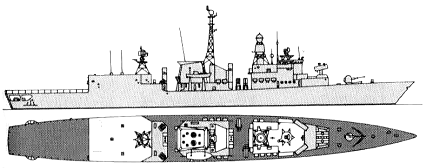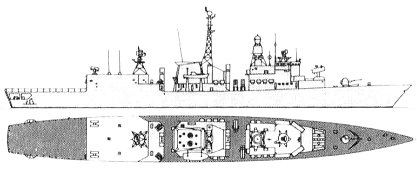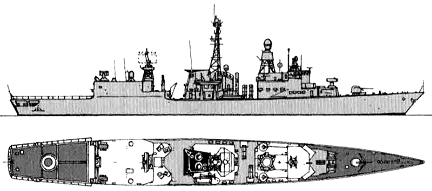
NAVYPEDIA
 Support the project with paypal
Support the project with paypal
Photo

Lübeck 2008
Ships
| Name | No | Yard No | Builder | Laid down | Launched | Comp | Fate |
|---|---|---|---|---|---|---|---|
| Bremen | F207 | Bremer Vulkan, Bremen | 9.7.1979 | 27.9.1979 | 7.5.1982 | stricken 3.2014 | |
| Niedersachsen | F208 | Weser, Bremen | 9.11.1980 | 9.6.1980 | 15.10.1982 | stricken 6.2015 | |
| Rheinland-Pfalz | F209 | Blohm & Voss, Hamburg | 25.9.1979 | 3.9.1980 | 9.5.1983 | stricken 3.2013 | |
| Emden | F210 | Nordseewerke, Emden | 23.6.1979 | 17.12.1980 | 7.10.1983 | stricken 11.2013 | |
| Köln | F211 | Blohm & Voss, Hamburg | 16.6.1980 | 29.5.1981 | 19.10.1984 | stricken 7.2012 | |
| Karlsruhe | F212 | Howaldtswerke, Kiel | 10.3.1981 | 8.1.1982 | 19.4.1984 | stricken 6.2017 | |
| Augsburg | F213 | Bremer Vulkan, Bremen | 4.4.1987 | 17.9.1987 | 3.10.1989 | in service (2019) | |
| Lübeck | F214 | Nordseewerke, Emden | 1.6.1987 | 15.10.1987 | 19.3.1990 | in service (2019) |
Technical data
| Displacement standard, t | 2930 |
|---|---|
| Displacement full, t | 3780 |
| Length, m | 121.8 wl 130.0 oa |
| Breadth, m | 14.4 |
| Draught, m | 4.26 hull 6.00 sonar |
| No of shafts | 2 |
| Machinery | CODOG: 2 General Electric-Fiat LM-2500 gas turbines / 2 MTU 20V956 TB92 diesels |
| Power, h. p. | 50000 / 10400 |
| Max speed, kts | 30 |
| Fuel, t | gas turbine / diesel oil 610 |
| Endurance, nm(kts) | 5700(17) |
| Armament | 2 x 4 Harpoon SSM (8 RGM-84A), 1 x 8 Sea Sparrow SAM (24 RIM-7M), 1 x 1 - 76/62 OTO Melara Compact, 2 x 2 - 324 Mk 32 TT (8 Mk 46 + 16 Mk 46 for helicopters), 2 helicopters (Lynx) |
| Electronic equipment | 3RM20, DA-08, WM-25, STIR-18 radars, DSQS-21B(Z) sonar, FL-1800S ECM suite, 4x Mk 36 SRBOC decoy RL, SLQ-25 Nixie torpedo decoy, SABRINA CCS |
| Complement | 199 |
Standard scale images

Bremen 1985

Rheinland-Pfalz 1990

Bremen 2000

Niedersachsen 2000
Graphics
Project history
Preparatory works on the design of new fighting ships began with the institution of the new navy in 1955-56, but until the 1960s all design was based on the knowledge and experience of wartime officers and civil servants who had re-enlisted. The German shipbuilding industry was faced with the problem of closing a ten-year gap in design experience. The design of the Hamburg and Köln classes was commendable given the short space of time in which it was produced, but like other contemporary designs they suffered from the WEU's displacement limit, which resulted in too many components for the displacement. This is why all the units of the first shipbuilding programme look so voluminous and have such high superstructures.
The role of Types 101 and 120 were very clearly defined: escorting convoys against submarines and aircraft, repelling of surface attack plus minelaying ability. At this time the submarine, the chief opponent, was diesel-powered, and the aircraft menace was represented by fighter-bombers. The weaponry of this first generation of German surface combatants clearly matched these requirements: panoramic aircraft -warning radars plus gun-directors for quick reaction. The 100mm turrets plus the 40mm produced the necessary gun component. The destroyers' propulsion consisted of conventional steam turbines, the frigates had diesels plus gas turbines for dash speed. But the tremendous development in engineering technology, nuclear propulsion, new weapons and electronic guidance systems, made conventional warships of this first generation quickly obsolete
During the 1960s preliminary studies for a follow-up type were produced. The first design was for an AA corvette of 1200t displacement, ten of which were envisaged. But the increasing submarine menace necessitated an ASW component which forced the displacement up to 2500t. Because of the restricted defence budget of the German Federal Republic at this time, the project was dropped and in place of the new AA/ASW corvettes both the Lütjens class destroyers and the ten boats of the Zobel class were modernized.
The next design stage was the 'Frigate 70' which was to have incorporated all the required components. Although the budgetary board had accepted on 23 January 1969 and the defence board of the Bundestag had accepted this Type on 8 February 1969, the orders were cancelled because the design stage had not been completed and the displacement had risen to 3600t while the building costs had soared.
So design studies started again from scratch by comparing various foreign frigate designs of which the Netherlands' 'Standard' frigate of the Kortenaer class turned out to be optimal. On 17 July 1975, a 'Memorandum of Understanding' with the Netherlands was signed, followed by acceptance by the German Defence Board on 28 January 1976.
On 26 November 1977 six units were ordered, designated the Type 122, and a further two on 6 December 1985. The NATO Sea Sparrow system employs a Mk 21 launcher. The helicopters are Mk 88 Lynx with DAQS-13D dipping sonar and the Canadian Bear Trap system is fitted to the helicopter deck.
Modernizations
1991, Bremen, Niedersachsen, Karlsruhe: + 1 x 7 - 30/77 Goalkeeper, Goalkeeper radar
1993, Niedersachsen; 1994, Rheinland-Pfalz, Lübeck; 1995, Bremen, Emden; 1996, Karlsruhe, Augsburg; 1997, Köln: as type 122A: + 2 x 21 RAM SAM (42 RIM-116A), TAS6-3 towed sonar array
1994, Bremen, Niederesachsen, Karlsruhe: - 1 x 7 - 30/77, Goalkeeper radar
1997, Emden; 1999, Karlsruhe; 2000, Köln; 2002, Bremen, Augsburg; 2003, Lübeck, Niedersachsen, Rheinland-Pfalz: - DA-08 radar, FL-1800 ECM suite; + 2 x 1 - 20/90 Rh-202, TRS-3D/32 radar, TMS system (upgrade for WM-25 radar), 2x MSP 500 e/o systems, FL-1800S Stage II ECM suite
2003, Emden; 2004, Karlsruhe; 2005, Niedersachsen; 2006-2009, Bremen, Rheinland-Pfalz, Köln, Augsburg, Lübeck: - 2 x 1 - 20/90, SABRINA CCS; + 2 x 1 - 27/64 MLG-27, SATIR 2000 CCS
2016-2018, Augsburg, Lübeck: - 3RM20 radar; + Kelvin-Hughes 5000A radar
Naval service
No significant events.
 HOME
HOME FIGHTING SHIPS OF THE WORLD
FIGHTING SHIPS OF THE WORLD GERMANY
GERMANY ESCORTS
ESCORTS BREMEN frigates (1982 - 1990)
BREMEN frigates (1982 - 1990)
